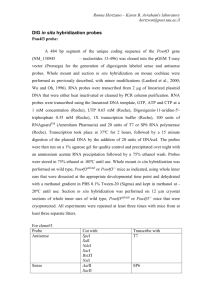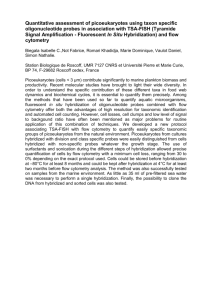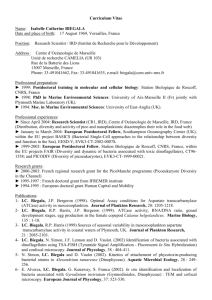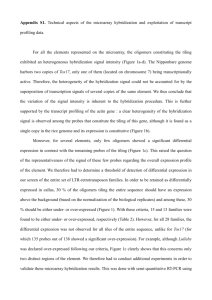Lectins and nucleic acids as molecular probes
advertisement
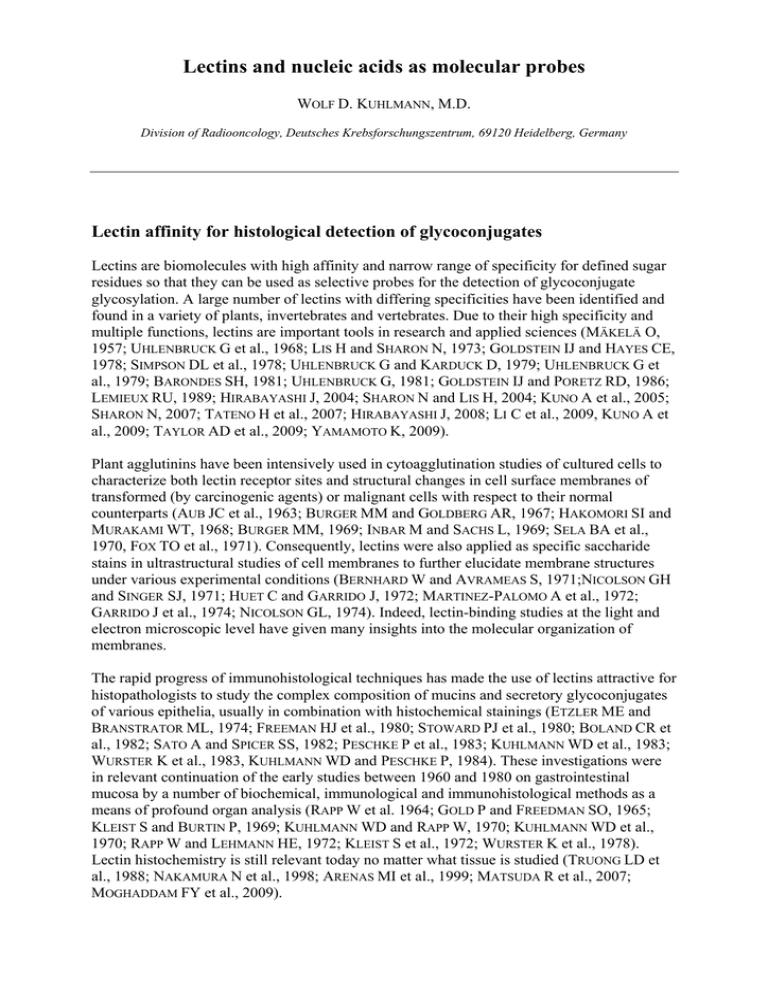
Lectins and nucleic acids as molecular probes WOLF D. KUHLMANN, M.D. Division of Radiooncology, Deutsches Krebsforschungszentrum, 69120 Heidelberg, Germany Lectin affinity for histological detection of glycoconjugates Lectins are biomolecules with high affinity and narrow range of specificity for defined sugar residues so that they can be used as selective probes for the detection of glycoconjugate glycosylation. A large number of lectins with differing specificities have been identified and found in a variety of plants, invertebrates and vertebrates. Due to their high specificity and multiple functions, lectins are important tools in research and applied sciences (MÄKELÄ O, 1957; UHLENBRUCK G et al., 1968; LIS H and SHARON N, 1973; GOLDSTEIN IJ and HAYES CE, 1978; SIMPSON DL et al., 1978; UHLENBRUCK G and KARDUCK D, 1979; UHLENBRUCK G et al., 1979; BARONDES SH, 1981; UHLENBRUCK G, 1981; GOLDSTEIN IJ and PORETZ RD, 1986; LEMIEUX RU, 1989; HIRABAYASHI J, 2004; SHARON N and LIS H, 2004; KUNO A et al., 2005; SHARON N, 2007; TATENO H et al., 2007; HIRABAYASHI J, 2008; LI C et al., 2009, KUNO A et al., 2009; TAYLOR AD et al., 2009; YAMAMOTO K, 2009). Plant agglutinins have been intensively used in cytoagglutination studies of cultured cells to characterize both lectin receptor sites and structural changes in cell surface membranes of transformed (by carcinogenic agents) or malignant cells with respect to their normal counterparts (AUB JC et al., 1963; BURGER MM and GOLDBERG AR, 1967; HAKOMORI SI and MURAKAMI WT, 1968; BURGER MM, 1969; INBAR M and SACHS L, 1969; SELA BA et al., 1970, FOX TO et al., 1971). Consequently, lectins were also applied as specific saccharide stains in ultrastructural studies of cell membranes to further elucidate membrane structures under various experimental conditions (BERNHARD W and AVRAMEAS S, 1971;NICOLSON GH and SINGER SJ, 1971; HUET C and GARRIDO J, 1972; MARTINEZ-PALOMO A et al., 1972; GARRIDO J et al., 1974; NICOLSON GL, 1974). Indeed, lectin-binding studies at the light and electron microscopic level have given many insights into the molecular organization of membranes. The rapid progress of immunohistological techniques has made the use of lectins attractive for histopathologists to study the complex composition of mucins and secretory glycoconjugates of various epithelia, usually in combination with histochemical stainings (ETZLER ME and BRANSTRATOR ML, 1974; FREEMAN HJ et al., 1980; STOWARD PJ et al., 1980; BOLAND CR et al., 1982; SATO A and SPICER SS, 1982; PESCHKE P et al., 1983; KUHLMANN WD et al., 1983; WURSTER K et al., 1983, KUHLMANN WD and PESCHKE P, 1984). These investigations were in relevant continuation of the early studies between 1960 and 1980 on gastrointestinal mucosa by a number of biochemical, immunological and immunohistological methods as a means of profound organ analysis (RAPP W et al. 1964; GOLD P and FREEDMAN SO, 1965; KLEIST S and BURTIN P, 1969; KUHLMANN WD and RAPP W, 1970; KUHLMANN WD et al., 1970; RAPP W and LEHMANN HE, 1972; KLEIST S et al., 1972; WURSTER K et al., 1978). Lectin histochemistry is still relevant today no matter what tissue is studied (TRUONG LD et al., 1988; NAKAMURA N et al., 1998; ARENAS MI et al., 1999; MATSUDA R et al., 2007; MOGHADDAM FY et al., 2009). In the case of histology, immunostaining methods (FITC labeling in immunofluorescence and, much later, peroxidase labeling techniques) became state-of-the-art. It could be shown that histochemical procedures (Alcian blue staining and subsequent refinements), immunostaining with specific antibodies and the use of lectin bindings had some potential for investigations on structure-function-relationships in gastrointestinal mucosa (KUHLMANN WD, 1984). In a similar way to immunohistologal techniques, lectins are either conjugated with markers such as fluorochromes, enzymes etc. and applied to tissue sections in direct staining techniques. Alternatively, lectins are used unconjugated and detected by indirect staining procedures. The following steps are involved: select lectins according to the desired study, choose a direct or indirect labeling method; use the lectins to localize the corresponding carbohydrate moieties in appropriate cell or tissue preparation; the carbohydrate-lectin complex is detected via marker molecules by a direct or indirect procedure according to the same principles described for immunohistology; visualization of the chromogen by enzyme substrate, UV light (f.e. fluorochromes) or other methods. There exist many variants of histological lectin stainings which, however, are basically the same as the respective techniques in immunohistology. Thus, the same marker molecules including detection principles known from immunohistology may be adapted. This includes also the combination of different labels in one experiment. From a number of lectin staining studies it was deduced that the successful use of the probes for glycoconjugate detection is not only governed by the chosen staining procedure (i.e. the applied detection principle such as a direct or an indirect method, the secondary reagents which includes the labelling substance), but also by the tissue preparation. Appropriate tissue handlings include fixation, dehydraton, embedding and pretreatment of specimens, and are equally important variables as described for immunohistology. All these factors influence specificity and sensitivity of lectin staining experiments (for details see chapters on tissue fixation, dehydration and histological embedding). Nucleic acids as probes for in situ hybridization The technique of in situ hybridization is another example of a specific histological stain by the use of special probes, first described in 1969 (GALL JG and PARDUE ML, 1969; JOHN HA et al., 1969; PARDUE ML and GALL JG, 1969). The technique allows the detection of specific nucleic acid sequences in chromosomes and morphologically intact cells or tissues. A high degree of spatial information in locating specific DNA or RNA sequences within the cells or in subpopulation of cells of a given tissue specimen can be achieved. Moreover, the combination with immunohistology will allow to relate topological information to gene activity at the DNA, mRNA and protein level. In situ hybridization may be used to identify sites of gene expression; analyze the tissue distribution of transcription; identify and localize pathogens (e.g. virus); follow changes in specific mRNA synthesis; chromosome mapping. DNA probe tests are based on the principle of a nucleic acid hybridization reaction, i.e. the formation of stable double-stranded nucleic acid molecules from complementary singlestranded molecules. The complementary base pairs are formed between adenine and thymine bases, and guanine and cytosine bases. Specific DNA probes can be designed to detect various genes, gene segments or gene products. When specific hybrids are formed between the target nucleic acid and the DNA probe, excess (unreacted) single-stranded DNA probes are separated from the hybrids by washings. The principle of in situ hybridization is derived from Southern and Northern blot methods, but it can detect the specific nucleic acid sequences in intact cells and tissues. Although the annealing of DNA or RNA molecules to their complementary sequences has been applied earlier for several purposes and by several techniques (e.g. in solution for scintillation counting or on nitrocellulose membranes for radioautography), in situ hybridization needed special histological preparation. In spite of the high sensitivity and wide applicability of in situ hybridization techniques, their use has been limited because at that time only radiositopes were available as labels. This changed with the introduction of molecular cloning of nucleic acids and and the introduction of non-radioactive detection methods. Since then, the technique has become established for the identification of DNA and RNA in many laboratories (LANGER PR et al., 1981; CHOLLET A and KAWASHIMA EM, 1985; GEBEYEHU G et al., 1987; GUITTENY AF et al., 1988; WARFORD A, 1988; HANKIN RC and LLOYD RV, 1989; PRINGLE JH et al., 1989; KESSLER C et al., 1990; LARSSON LI and HOUGAARD DM, 1990; KESSLER C, 1991; SHORROCK K et al., 1991; TRASK BJ, 1991; TRASK BJ et al., 1991; DURRANT I et al., 1995). Marker molecules including detection principles known from immunohistology play a major role in the application of cellular hybridization techniques. Furthermore, new perspectives in the application of in situ hybridization have been opened by the combination of different labels in one experiment. The many sensitive antibody detection systems available for such probes enhances the flexibility of the method (PARAGAS VB et al., 1997; SPEEL EJM et al., 1997; PERNTHALER A et al., 2002). The sensitivity of in situ hybridization methods is governed by several variables such as the preservation of nucleic acid during tissue preparation (f.e. fixation, dehydration, embedding), the accessibility of molecular probes to the target during hybridization, the specificity and activity of the secondary reagents and the sensitivity of the applied detection system. The concept of in situ hybridization for the localization of either DNA or RNA sequences is similar and follows these preparative steps: cell or tissue sampling, i.e. fixation and specimen preparation. Preparation in the case of whole tissues means dehydration, embedding and section pretreatment; probe labeling with a suitable marker; hybridization; localization of hybrids by an appropriate detection system. Selected publications for further readings Mäkelä O (1957) Aub JC et al. (1963) Rapp W et al. (1964) Gold P and Freedman SO (1965) Burger MM and Goldberg (1967) Hakomori SI and Murakami WT (1968) Uhlenbruck G et al. (1968) Burger MM (1969) Gall JG and Pardue ML (1969) Inbar M and Sachs L (1969) John HA et al. (1969) Kleist S and Burtin P (1969) Pardue ML and Gall JG (1969) Kuhlmann WD and Rapp W (1970) Kuhlmann WD et al. (1970) Sela BA et al. (1970) Bernhard W and Avrameas S (1971) Fox TO et al. (1971) Nicolson GL and Singer SJ (1971) Huet C and Garrido J (1972) Kleist S et al. (1972) Martinez-Palomo A et al. (1972) Rapp W and Lehmann HE (1972) Lis H and Sharon N (1973) Etzler ME and Branstrator ML (1974) Garrido J et al. (1974) Nicolson GL (1974) Goldstein IJ and Hayes CE (1978) Simpson DL et al. (1978) Wurster K et al. (1978) Uhlenbruck G and Karduck D (1979) Uhlenbruck G et al. (1979) Freeman HJ et al. (1980) Stoward PJ et al. (1980) Barondes SH (1981) Langer PR et al. (1981) Uhlenbruck G (1981) Boland CR et al. (1982) Sato A and Spicer SS (1982) Kuhlmann WD et al. (1983) Peschke P et al. (1983) Wurster K et al. (1983) Kuhlmann WD and Peschke P (1984) Chollet A and Kawashima EM (1985) Goldstein IJ and Poretz RD (1986) Gebeyehu G et al. (1987) Guitteny AF et al. (1988) Truong LD et al. (1988) Warford A (1988) Hankin RC and Lloyd RV (1989) Lemieux RU (1989) Pringle JH et al. (1989) Kessler C et al. (1990) Larsson LI and Hougaard DM (1990) Kessler C (1991) Shorrock K et al. (1991) Trask BJ (1991) Trask BJ et al. (1991) Durrant I et al. (1995) Paragas VB et al. (1997) Speel EJM et al. (1997) Nakamura N et al. (1998) Arenas MI et al. (1999) Pernthaler A et al. (2002) Hirabayashi J (2004) Sharon N and Lis H (2004) Kuno A et al. (2005) Sharon N (2007) Tateno H et al. (2007) Hirabayashi J (2008) Matsuda A et al. (2008) Kuno A et al. (2009) Li C et al. (2009) Moghaddam FY et al. (2009) Taylor AD et al. (2009) Yamamoto K (2009) © Prof. Dr. Wolf D. Kuhlmann, Heidelberg 22.01.2009
